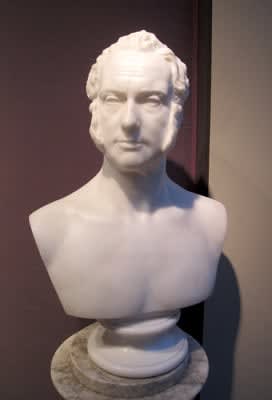
Luigi Persico
Marble Bust of Henry John Temple (1784-1865), 3rd Viscount Palmerston , mid 19th century
Marble
25 ½ inches (65 cm) high
Philip Mould & Co.
To view all current artworks for sale visit philipmould.com This previously unrecorded bust is a significant addition to the iconography of Lord Palmerston, one of Britain’s most celebrated statesmen,...
To view all current artworks for sale visit philipmould.com
This previously unrecorded bust is a significant addition to the iconography of Lord Palmerston, one of Britain’s most celebrated statesmen, a founder of Liberalism, and a leading exponent of forceful interventionism to protect British interests abroad. It is by the Italian-born artist Luigi Persico, who is best known for his series of important sculptures in the United States including works such as Genius of America, commissioned by President John Quincy Adams for the Capitol in Washington. Persico’s career in America had been launched by a widely lauded and reproduced bust of c.1825 of the Marquis de Lafayette [example in the Library Company of Philadelphia], the French nobleman who had volunteered in the Washington’s continental army.
Sittings for Palmerston’s bust took place in the summer of 1845 at Palmerston’s London house in Carlton Terrace, and are recorded by Palmerston in a letter to Henry Vane, 2nd Duke of Cleveland on 8th August 1845:
‘Your protégé Persico begged and prayed that I would sit, or rather stand to him for a bust. I have done so, not without a good deal of inconvenience, just as I was about to leave town and had all sorts of things to do: I believe he has made a good one. He is a clever man and a good artist.’
Persico had recently arrived in London from Naples that summer and, perhaps hoping to recreate the success of his Lafayette bust, was no doubt keen to make his mark with an important portrait commission. At the time, there were few greater ‘Men of the Day’ than Palmerston, who although then in opposition during the government of Sir Robert Peel, had already made his mark as an active Foreign Secretary from 1830-34 and 1835-41, and was shortly about to the Foreign Office in the administration of his great rival, Lord John Russell. He would of course later become a famously active Prime Minister when it came to Foreign affairs, not least in the successful prosecution of the Crimean War.
Although Palmerston sat for a number of busts throughout his career, to sculptors such as Matthew Noble and Richard Lucas, the present likeness by Persico is the only sculpture of him by a foreign artist. As a result, the bust is free of the occasionally over-bearing formality of Victorian sculpture at its most Augustan, and Palmerston is here rendered with great delicacy and freedom of movement. Persico did not remain in England for long, and it is possible, given the recent provenance of this work, that he took the bust back to Italy with him.
This previously unrecorded bust is a significant addition to the iconography of Lord Palmerston, one of Britain’s most celebrated statesmen, a founder of Liberalism, and a leading exponent of forceful interventionism to protect British interests abroad. It is by the Italian-born artist Luigi Persico, who is best known for his series of important sculptures in the United States including works such as Genius of America, commissioned by President John Quincy Adams for the Capitol in Washington. Persico’s career in America had been launched by a widely lauded and reproduced bust of c.1825 of the Marquis de Lafayette [example in the Library Company of Philadelphia], the French nobleman who had volunteered in the Washington’s continental army.
Sittings for Palmerston’s bust took place in the summer of 1845 at Palmerston’s London house in Carlton Terrace, and are recorded by Palmerston in a letter to Henry Vane, 2nd Duke of Cleveland on 8th August 1845:
‘Your protégé Persico begged and prayed that I would sit, or rather stand to him for a bust. I have done so, not without a good deal of inconvenience, just as I was about to leave town and had all sorts of things to do: I believe he has made a good one. He is a clever man and a good artist.’
Persico had recently arrived in London from Naples that summer and, perhaps hoping to recreate the success of his Lafayette bust, was no doubt keen to make his mark with an important portrait commission. At the time, there were few greater ‘Men of the Day’ than Palmerston, who although then in opposition during the government of Sir Robert Peel, had already made his mark as an active Foreign Secretary from 1830-34 and 1835-41, and was shortly about to the Foreign Office in the administration of his great rival, Lord John Russell. He would of course later become a famously active Prime Minister when it came to Foreign affairs, not least in the successful prosecution of the Crimean War.
Although Palmerston sat for a number of busts throughout his career, to sculptors such as Matthew Noble and Richard Lucas, the present likeness by Persico is the only sculpture of him by a foreign artist. As a result, the bust is free of the occasionally over-bearing formality of Victorian sculpture at its most Augustan, and Palmerston is here rendered with great delicacy and freedom of movement. Persico did not remain in England for long, and it is possible, given the recent provenance of this work, that he took the bust back to Italy with him.
Provenance
Italian Private CollectionBe the first to hear about our available artworks
* denotes required fields
We will process the personal data you have supplied in accordance with our privacy policy (available on request). You can unsubscribe or change your preferences at any time by clicking the link in our emails.